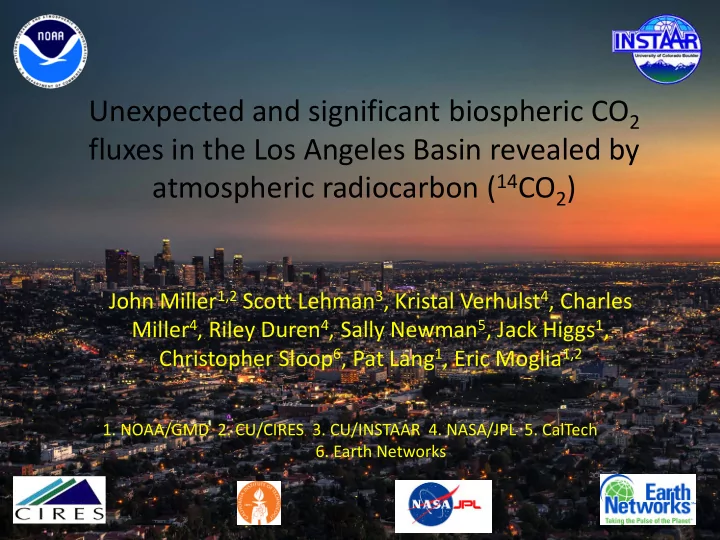

Unexpected and significant biospheric CO 2 fluxes in the Los Angeles Basin revealed by atmospheric radiocarbon ( 14 CO 2 ) John Miller 1,2 Scott Lehman 3 , Kristal Verhulst 4 , Charles Miller 4 , Riley Duren 4 , Sally Newman 5 , Jack Higgs 1 , Christopher Sloop 6 , Pat Lang 1 , Eric Moglia 1,2 1. NOAA/GMD 2. CU/CIRES 3. CU/INSTAAR 4. NASA/JPL 5. CalTech 6. Earth Networks
“Megacities” Goals and Approach “Develop and demonstrate measurements systems capable of quantifying trends in the anthropogenic carbon emissions of the Los Angeles Megacity (target: 10% change in Fossil Fuel CO 2 over 5 years).” 1. Difficult without understanding biogenic contributions; 2. Biogenic contributions difficult without 14 C. 3. But general concept for urban emissions monitoring is to measure CO 2 assuming that its variations are purely anthropogenic. 2
Atmospheric 14 CO 2 looks just like fossil CO 2 -2.5 per mil ∆ 14 C = 1 ppm CO 2 -fossil ESP DND MBO MSH Aircraft Tower ∆ 14 C CO 2-fos Miller et al, 2012 Includes ecosystems, oceans, nuclear Includes only fossil fuel power, cosmic rays, fossil fuel. 3
CO 2 variations can be separated into Biogenic and Fossil fractions using ∆ 14 C. CO 2 xs C obs = C bg + C fos + C bio ( ∆ x C) obs = ( ∆ x C) bg + ( ∆ x C) fos + minor Bio has no influence 4
LA Basin 14 CO 2 sampling sites Niwot Ridge, CO background sites 5
CO 2 and 14 CO 2 data show large variations with a clear fossil fuel contribution. Background (NWR, MWO) USC Granada Hills CS Fullerton 100 per mil!! ~ 40 ppm fos. CO2. 6
Biospheric contribution to total CO 2 is substantial. USC Larger enhancements in Granada Hills winter – less vertical CS Fullerton mixing Seasonally varying biosphere contribution with summer uptake. Summer biosphere drawdown is underrepresented because of enhanced mixing Variability in CO 2 xs,bio and fos are likely dominated by changes in mixing. 7
Isotopic mixing analysis also shows substantial biospheric contribution throughout the year. Why is CO 2 bio so high? Ethanol in gasoline (~ 3 %) • Human Respiration (~ 5 %) • Urban ecosystems 10-15% ? • Winter: -760 per mil CO 2 xs is 24% biogenic Summer: -830 per mil CO 2 xs is 17% biogenic 8
High correlation of Bio and Fossil components consistent with co-located distributed sources. • Fossil fuels (and ethanol), and human population are similarly distributed throughout the Basin. • Urban ecosystems may also be. • N.B.: Correlation is analyzed in winter to avoid near zero CO 2 bio signal resulting from net photosynthesis. 9
How productive are urban ecosystems? "Soil respiration (~7 umol/m2/s) … in urban ecosystems was …2.5 to five times greater than any other land-use type.” ( Kaye et al., Global Change Biology (2005) ) Harvard forest summer respiration fluxes are only ~ 4 umol/m2/s. These fluxes would require ~1/10th of LA to be covered by lawns (and golf course, parks, etc.) to explain our observations . Is this realistic? 10
LANDSAT 30 m EVI Distribution of green appears to be somewhat decoupled from people and roads, but still widespread. 11
LANDSAT 30 m EVI zoomed in shows even more. Quickbird/Google Earth (~50 cm) shows yet more. 12
Wintertime biospheric CO 2 fraction averages ~50% for regions; ~ 20% for cities N. America Europe Asia 56% 42% 50% 23% 41% 51% 19% 72% 21% 10% 52% 17% 20% 51% 45% Thanks to: K. Rozanski, M. Zimnoch (Poland); I. Levin (Germany); Morgan Lopez(France); L. Zhou (China); Korea-China 13 Center for Atmos. Res.
Summary and implications 1. CO 2 xs ≠ CO 2 fos, even in L.A. 2. Remote-sensing and in situ approaches for urban CO 2 fluxes need to account for biospheric CO 2 . 3. CO 2 bio varies throughout the year, but it will likely vary year to year, and its ratio with CO 2 fos will likely trend with emissions reductions. 4. Continued and widespread measurement of urban biosphere fluxes will be required to isolate the fossil fuel emissions signal. 14
15
Nighttime signals show more biogenic signal and small signals overall. Differences may reflect suppressed atmospheric mixing at night with lower fossil emissions. 16
CO:CO 2 correlations – CO 2 fos Summer v. Winter 17
Transforming in situ CO to CO 2 ff Granada Hills in situ data • Just an example, for now… • Yellow represents mid- day hours – i.e. only CO 2 fos_syn = COxs/10.2 when our CO/CO 2 fos values are valid. • Evidence for diurnal variability in CO:CO 2 Huuuge signals, but are they too big? 18
Why Megacities? Large emissions and large signals. But… * Duren and Miller, Nat. C.C., 2012 der picture of LA with multiple obs systems. Megacity > 10 million; 2010 = 22 cities; 2025 = 38 cities LA is ~ 17 million 19 * However, this is still only ~ 10% of global emissions.
Recommend
More recommend